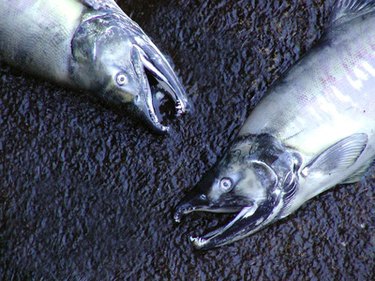Things You'll Need
Fillet knife
Paper towels or gloves (optional)

Salmon are prized by anglers for their fighting spirit and by gourmands for their meaty flesh and versatility in the kitchen. Removing the scales from a salmon's silvery sides is not a necessity, but many cooks prefer to de-scale the fish before putting it in the oven or on the grill to prevent the errant scale or two from despoiling the presentation of the fish on the plate. As the knife blade passes over the scales, it lifts them and scrapes them off the skin.
Step 1
Rinse the salmon under cool running water. Water facilitates scaling, so it helps to work near a sink.
Video of the Day
Step 2
Grasp the salmon by the tail. Use fish-cleaning gloves or a paper towel to help maintain a good grip.
Step 3
Position the blade of the fillet knife crosswise on the fish with the blade against the skin. Hold the blade at an angle — 45 degrees or so — with the dull edge of in the direction of the head.
Step 4
Scrape the knife blade against the side of the fish, toward the head. As the scales release, you feel a corresponding diminution of resistance indicating you cleared the scales from that area.
Step 5
Continue scraping until you have cleared all the scales on one side of the fish. Turn the fish over and remove the scales from the opposite side.
Step 6
Rinse the fish thoroughly when done. Examine both sides of the salmon for any remaining scales and scrape them away as needed.
Tip
It's easier to remove scales before you clean the fish.
Video of the Day